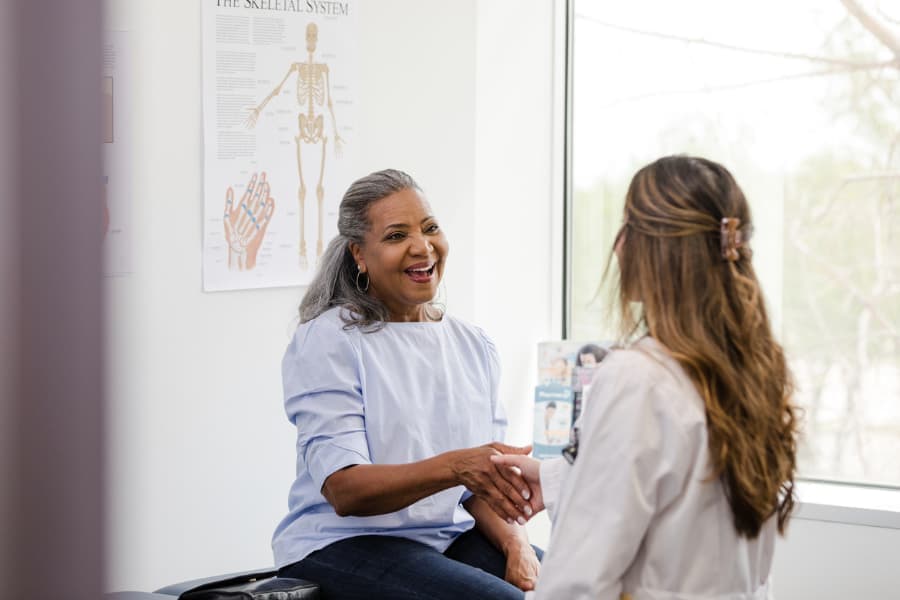Treatment for Overactive Bladder in Staten Island, NY
Overactive bladder is a condition that creates a frequent, urgent need to urinate. Though common, its impact on a patient’s work and social life can be significant. Self-consciousness may also prevent patients from discussing their symptoms with a physician. Luckily, overactive bladder can be treated. Richmond University Medical Center’s Urology Services Center in Staten Island, NY, offers a variety of treatment options, from simple lifestyle changes to nerve stimulation and medication. Get in touch today to learn more about urology services, including a focus on urology for women.

What Causes an Overactive Bladder?
Urine is made in the kidneys and drains into the bladder. A tight muscle called the urethral sphincter keeps the urine from leaving the bladder. As the bladder fills, nerve signals tell the brain that it is time to urinate. The signal causes the pelvic floor and the urethral sphincter to relax. This allows the urine to leave the body. At the same time, the bladder muscles tighten, or contract, to push urine out through the open sphincter.
Overactive bladder, or OAB, occurs when the bladder muscles contract on their own. These involuntary contractions create the urgent need to urinate. There are many reasons bladder muscles might contract involuntarily, including:
- Bladder stones or tumors
- Urinary tract infections
- Enlarged prostate
- Constipation
- Diabetes
- Abdominal trauma
- Stroke and other nerve conditions
- Hormonal changes during menopause
- Age-related cognitive decline
- Medication side effects
- Past surgeries
Identifying the cause of OAB is important. A urologist will conduct a physical exam, urinalysis, ultrasound, computed tomography (CT) scan, and other tests to diagnose the source of a patient’s condition. The diagnosis will inform treatment plans to ensure the best outcome.
Risk Factors for OAB
Overactive bladder is common, affecting up to 33 million people in the United States. Some individuals, however, are more susceptible than others. A patient may be at a greater risk of an overactive bladder if they:
- Are over the age of 65
- Are assigned female at birth
- Are overweight or obese
- Have declining mental ability due to a stroke or Alzheimer’s
- Consume large amounts of caffeine or alcohol
- Use certain medications
- Have undergone previous surgeries on the urinary system
- Are or have been pregnant
Risk factors do not guarantee a patient will ever have an overactive bladder, but they can contribute to one’s chances of developing OAB. If one or more of these factors apply, patients should pay attention to their bodies and contact a physician if they develop any symptoms of OAB.
Signs and Symptoms of Overactive Bladder
Symptoms of an overactive bladder are often easily recognizable. All symptoms are related to urinary incontinence, or an inability to control the bladder. Here are some overactive bladder symptoms:
- Sudden, uncontrollable urges to urinate
- Frequent urination
- Leaking urine
- Waking up more than twice a night to urinate
An overactive bladder also may affect a patient’s life in other ways. Because symptoms of OAB often are disruptive, they can impact one’s day-to-day comfort and lifestyle. Patients may experience:
- Anxiety
- Emotional distress
- Depression
- Sleep disturbances
- Sexual problems
An overactive bladder does not go away on its own. Without prompt treatment, symptoms may get worse over time. If a patient’s symptoms are causing distress or discomfort in their day-to-day life, it may be time to contact a physician. Medical treatment is the only way to experience a full recovery and long-term relief.
Treatments for Overactive Bladder
Depending on the cause of OAB, there are multiple treatment options available. The physicians at Richmond University Medical Center’s Urology Services Center will meet with patients to discuss their symptoms and develop a plan to address the condition effectively. Physicians may recommend:
- Diet adjustments: A physician may ask patients to reduce the consumption of foods and drinks that cause bladder symptoms, including caffeinated beverages, alcohol, fruit, chocolate, tomato products, artificial sweeteners, and spicy or acidic foods.
- Bladder retraining: Setting a consistent bathroom schedule and performing certain exercises can help gradually increase intervals between urinating and restore a normal cycle.
- Nerve stimulation: Physicians implant a small neurotransmitter that sends out mild electrical impulses. The impulses counteract nerve signals and reduce the need to urinate.
- Botulinum injections: A small injection of Botulinum toxin, or Botox, can relax muscles around the bladder to reduce contractions. Injections typically are repeated every six months.
- Medication: Some medications work to counteract muscle contractions and spasms, increasing the bladder’s capacity so patients can go longer without urinating.
Find Relief From Overactive Bladder
For patients struggling with overactive bladder, treatment is available through the Urology Services Center located at 1200 South Avenue, Staten Island, NY. Contact us to learn more about high-quality care services at Richmond University Medical Center or call 718-370-1400 to make an appointment.



